| Botanical Name |
|
| Family |
Fabaceae - The legume and pod-bearing family. (Pea & Bean Family) |
| Pronunciation |
sor-RAY-lee-uh pin-NAY-tuh |
| Common Name(s) |
English: Blue Pea; Fountain Bush; Fountain Tree; African Scurfpea
Afrikaans: Bloubos; Bloukeur; Fonteinbos; Penwortel
IsiXhosa: Umhlonishwa; Umhlonitshwa
IsiZulu: Umhlongani; Umhlonishwa
Australia: Albany broom; Blue broom; Blue butterfly bush
|
| Plant Group |
- Shrub A woody plant of relatively low height, having several stems arising from the base and lacking a single trunk; a bush.
|
| Plant Size |
- Large
| Tree | 18m to 25m |
| Shrub | 3m to 4m |
| Perennial/ground cover | 75cm to 1m |
| Bulb | 80cm to 1.2m |
| Succulent | 1m to 1.5m |
|
| Position |
- Light or Dappled Shade Found below trees with sparse, open foliage. Ideal for the protection of herbaceous plants.
- Partial Shade The area is in shade for part of the day and in full sun for part of the day.
- Sun The area is in full sun for all or most of the day, all year round.
|
| General Information |
- Drought Tolerance: Moderate The plant is moderately adapted to arid conditions and can survive short periods of drought and high temperatures without extra water.
- Evergreen Plants that have leaves all year round.
- Fragrant / Aromatic These plants posses a strong, usually pleasant odour.
- Frost: Half-hardy The plant is able to survive low temperatures and some frost but requires protection against severe frost.
- Sand tolerant Plants adapted to survive in nutrient poor, very sandy soils.
- Water Moderate These plants will need some extra watering compared to water-wise plants. Plant them together, in at least some shade and in a convenient proximity to the house so that grey water can be utilised during times of drought.
- Wind Tolerant Plants able to withstand the effect of strong winds.
|
| Specific Information |
Psoralea pinnata is an attractive, short-lived (8-12 years) shrub or small tree, thick and bushy, with slender, graceful branches. The very green, soft looking, narrow, needle-like leaves are bristly to the touch and slightly aromatic, being dotted with tiny oil glands. It is very fast growing and can reach 1.5 m in a year. The base of the shrub becomes bare with age.
Although the individual flowers are not showy, the massed effect is pleasing with a sweet fragrance, often compared to grape cooldrink. The flowers are particularly loved by bees. After flowering, single seeded pods are produced. This species self-seeds quite easily.
Plant in full sun along the coast and in filtered shade further inland where overhanging branches will protect it from frost or very high temperatures. While appealing when grown in suitable conditions, this shrub does not look its best when grown out of its element.
Psoralea pinnata is a highly invasive weed in parts of Australia where it threatens heathlands, woodlands, forests, swampy areas and coastal vegetation.
|
| Ad Break |
|
| Flowers |
| Description |
pea flowers (similar to 'sweet peas') clustered at the ends of branches
|
| Season |
- Spring to Summer Plants will seldom bloom for the entire season as given in the list, but should flower during a period within these parameters.
|
| Colour |
|
| Growth Rate |
- Very Fast Specifying growth rate can be very misleading as there is considerable variation of growth rate depending on type and species of plant, available water, supplementary feeding, mulching and general care, as well as the plants suitability and adaptability to the garden environment.
|
| Plant Uses |
- Attracts bees, butterflies or other insects This plant attracts insects which can be food for birds or other creatures in your garden.
- Attracts Birds This plant will attract birds.
- Border A strip of ground, at the edge of a driveway or path in which ornamental plants or shrubs are planted.
- Boundary A plant useful for planting around the edges of the property to form a green or colourful backdrop, an impenetrable hedge, to hide walls or create privacy.
- Filler Either a fast growing tree or shrub used temporarily to fill in an area while the permanent plants grow to a desired size, or a plant used to fill gaps in borders or beds.
- Pioneer for new gardens A very fast growing plant, able to withstand hardship, that can be used to populate land that has recently been cleared of natural vegetation. These plants pave the way for slower-growing species by adding nutrients to the soil and creating leaf litter.
- Suitable for coastal gardens Plants adapted to dry, sandy soil, forceful wind, limited rainfall and intense sunlight.
- Suitable for seaside gardens Plants that will survive the hostile environment of harsh salty winds, dry sandy soil, irregular rainfall and heat found in seaside gardens.
- Suitable for smaller gardens Such plants do not have invasive root systems, remain small or controllable and can often be grown in containers.
- Water Features These plants may have dramatic, lush foliage or graceful form. They do not shed excessive leaves and do not have invasive root systems.
- Wild Garden An indigenous garden planted for the benefit of wildlife and birds. Provides food, water, a variety of mini-biomes and no poisonous chemicals are used.
- Windbreak Trees planted in a row to form protection from prevailing winds by breaking the force of the wind, thereby reducing wind damage.
|
| Distribution and Habitat |
in the Western Cape from Clanwilliam, south to the peninsula, and north-east to the Eastern Cape, KwaZulu-Natal, Swaziland and Mphumalanga, along streams and in wet places
|
| Planting Suggestions |
Plant Psoralea pinnata in well drained soil and a topdressing of compost. Mulch deeply to retain moisture. Water well while young and bear in mind that this plant comes from a winter rainfall area. Once established it needs less water and will survive occasional drought.
Psoralea pinnata can be pruned after blooming to limit its size alter its shape. Prune out interior branches to keep it looking its best. Hide the base of older plants with shade-loving sub-shrubs or perennials.
|
| Medicinal Uses |
Psoralea pinnata is reportedly used by healers as an emetic.
|
| Ad Break |
|


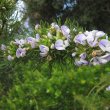
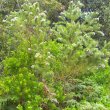
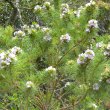
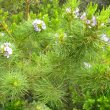
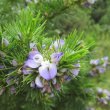


Comments
psoralea pinnata
Will this plant grow on the south side of the house getting wind from the sea, our house is about 800m from the sea and the soil is very sandy.
Psoralea pinnata
Hi Arnike
As I have been unable to grow this plant successfully in my garden (too dry and alkaline), my knowledge of it is scanty. However, according to the experts, it grows naturally along streams and in wet places. This would mean that you would need to mix the soil with plenty of compost and mulch deeply. You would also need to ensure that it is regularly watered, especially while young.
I would give it a trial period but I can't guarantee success. Hopefully another reader will be able to supply more information.
Kind regards
Lorraine
Es eta epecie Psoralea
Es eta epecie Psoralea pinnata? Es un árbol de 6 metros de alto y una copa de 6 metros. Se tiene en Armenia Colombia
It is Psoralea pinnata epecie eta? Tree is 6 feet tall and a circumference of 6 meters. It is in Armenia Colombia
Identification
Hi Luis
The picture you have sent is not a species of Psoralea. Psoralea belong to the pea and bean family. They all have pea flowers but your picture shows catkins, which is a different kind of flower. Also look at the leaves in the picture. The leaves of Psoralea are thin, like needles.
Kind regards
Lorraine
Discuss this plant
Share knowledge, ask a question or give an experience.